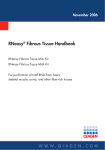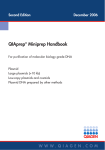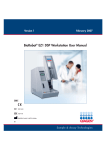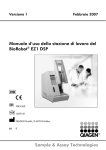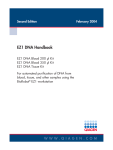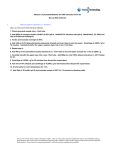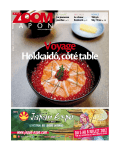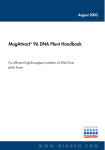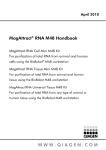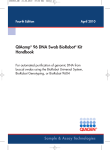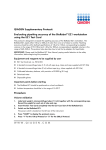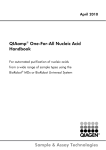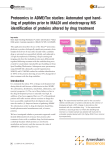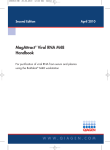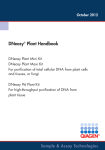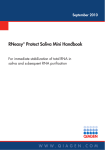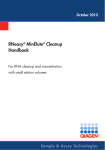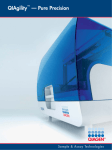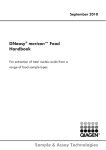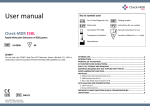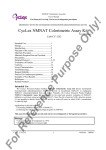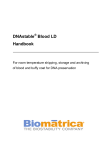Download RNeasy 96 BioRobot 8000
Transcript
October 2006 RNeasy® 96 BioRobot® 8000 Handbook For high-throughput RNA purification from animal and human cells, automated on the BioRobot Universal System, BioRobot Gene Expression — Real-Time RT-PCR, or BioRobot 8000 W W W. Q I A G E N . C O M Trademarks: QIAGEN®, BioRobot®, HotStarTaq®, MinElute®, Omniscript®, QuantiTect®, RNeasy®, Sensiscript® (QIAGEN Group); ABI PRISM®, Applied Biosystems® (Applera Corporation or its subsidiaries); Agilent® (Agilent Technologies, Inc.); LightCycler®, TaqMan® (Roche Group); SYBR® (Molecular Probes, Inc.). QIAzol Lysis Reagent is a subject of US Patent No. 5,346,994 and foreign equivalents. Purchase of QuantiTect SYBR Green Kits is accompanied by a limited, non-transferable immunity from suit to use it with detection by a dsDNA-binding dye as described in U.S. Patents Nos. 5,994,056 and 6,171,785 and corresponding patent claims outside the United States for the purchaser’s own internal research. No real-time apparatus or system patent rights or any other patent rights, and no right to use this product for any other purpose are conveyed expressly, by implication or by estoppel. QuantiTect Probe Kits and QuantiTect Multiplex Kits are an Authorized 5' Nuclease Core Kit without Licensed Probe. Its purchase price includes a limited, non-transferable immunity from suit under certain patents owned by Roche Molecular Systems, Inc. or F. Hoffmann-La Roche Ltd, for using only this amount of the product in the practice of the 5' nuclease process solely for the purchaser’s own internal research when used in conjunction with Licensed Probe. No right under any other patent claims (such as apparatus or system claims) and no right to use this product for any other purpose is hereby granted expressly, by implication or by estoppel. Further information on purchasing licenses may be obtained by contacting the Director of Licensing, Applied Biosystems, 850 Lincoln Centre Drive, Foster City, California 94404, USA. Purchase of the QuantiTect SYBR Green RT-PCR Kit, QuantiTect Probe RT-PCR Kit, and QuantiTect Multiplex RT-PCR Kits is accompanied by a limited, non-transferable license under RT and Reverse Transcription-PCR patents owned by Roche Molecular Systems, Inc. and F. Hoffmann-La Roche Ltd to use it for the purchaser’s own internal research. No real-time patent rights of any kind, no right under any other patent claims (such as apparatus or system claims), and no right to use this product for any other purpose is hereby granted expressly, by implication or by estoppel. QuantiTect Primer Assays are compatible for use in the 5' nuclease process or the dsDNA-binding dye processes covered by patents owned by Roche or owned by or licensed to Applera Corporation. No license under these patents to practice the 5' nuclease process or the dsDNA-binding dye processes are conveyed expressly or by implication to the purchaser by the purchase of this product. © 2002–2006 QIAGEN, all rights reserved. Contents Kit Contents 4 Storage 4 Quality Control 4 Product Use Limitations 5 Product Warranty and Satisfaction Guarantee 5 Technical Assistance 5 Safety Information 6 Introduction Principle and procedure 7 7 Equipment and Reagents to Be Supplied by User 10 Important Notes 11 Amount of cells 11 Handling and storing starting material 12 S-Blocks 12 Preparation of reagents and worktable 12 Protocol ■ Purification of Total RNA from Animal or Human Cells 18 Troubleshooting Guide 21 Appendix A: General Remarks on Handling RNA 24 Appendix B: Storage, Quantification, and Determination of Quality of RNA 26 Appendix C: Formaldehyde Agarose Gel Electrophoresis 28 Appendix D: Optional On-Plate DNase Digestion with the RNase-Free DNase Set 30 Appendix E: RT-PCR and Real-Time RT-PCR 31 Ordering Information 35 QIAGEN Distributors and Importers 39 RNeasy 96 BioRobot 8000 Handbook 10/2006 3 Kit Contents RNeasy 96 BioRobot 8000 Kit (12) Catalog no. 967152 Number of preps 12 x 96 RNeasy 96 Plates 12 Register Cards (96-well) 12 S-Blocks* 2 Elution Microtubes CL 12 x 96 Caps for Strips 165 x 8 Buffer RLT † 2 x 220 ml Buffer RW1† 6 x 350 ml ‡ Buffer RPE (concentrate) 6 x 100 ml RNase-Free Water 96 x 1.9 ml Top Elute Fluid 48 x 1.48 ml Handbook 1 * Reusable; see page 12 for cleaning instructions. † Contains a guanidine salt. Not compatible with disinfecting reagents containing bleach. See page 6 for safety information. ‡ Add 4 volumes of ethanol (96–100%) before use to obtain a working solution. The following kit components are also available separately: S-Blocks, Elution Microtubes CL (including caps for strips), Buffer RLT, and Top Elute Fluid. See page 35 for ordering information. Storage The RNeasy 96 BioRobot 8000 Kit, including all reagents and buffers, should be stored dry at room temperature (15–25°C) and is stable for at least 9 months under these conditions. Quality Control In accordance with QIAGEN’s ISO-certified Quality Management System, each lot of RNeasy 96 BioRobot 8000 Kit is tested against predetermined specifications to ensure consistent product quality. 4 RNeasy 96 BioRobot 8000 Handbook 10/2006 Product Use Limitations The RNeasy 96 BioRobot 8000 Kit is intended for research use. No claim or representation is intended to provide information for the diagnosis, prevention, or treatment of a disease. All due care and attention should be exercised in the handling of the products. We recommend all users of QIAGEN® products to adhere to the NIH guidelines that have been developed for recombinant DNA experiments, or to other applicable guidelines. Product Warranty and Satisfaction Guarantee QIAGEN guarantees the performance of all products in the manner described in our product literature. The purchaser must determine the suitability of the product for its particular use. Should any product fail to perform satisfactorily due to any reason other than misuse, QIAGEN will replace it free of charge or refund the purchase price. We reserve the right to change, alter, or modify any product to enhance its performance and design. If a QIAGEN product does not meet your expectations, simply call your local Technical Service Department or distributor. We will credit your account or exchange the product — as you wish. Separate conditions apply to QIAGEN scientific instruments, service products, and to products shipped on dry ice. Please inquire for more information. A copy of QIAGEN terms and conditions can be obtained on request, and is also provided on the back of our invoices. If you have questions about product specifications or performance, please call QIAGEN Technical Services or your local distributor (see back cover). Technical Assistance At QIAGEN we pride ourselves on the quality and availability of our technical support. Our Technical Service Departments are staffed by experienced scientists with extensive practical and theoretical expertise in molecular biology and the use of QIAGEN products. If you have any questions or experience any difficulties regarding the RNeasy 96 BioRobot 8000 Kit or QIAGEN products in general, please do not hesitate to contact us. QIAGEN customers are a major source of information regarding advanced or specialized uses of our products. This information is helpful to other scientists as well as to the researchers at QIAGEN. We therefore encourage you to contact us if you have any suggestions about product performance or new applications and techniques. For technical assistance and more information please call one of the QIAGEN Technical Service Departments or local distributors (see back cover). RNeasy 96 BioRobot 8000 Handbook 10/2006 5 Safety Information When working with chemicals, always wear a suitable lab coat, disposable gloves, and protective goggles. For more information, please consult the appropriate material safety data sheets (MSDSs). These are available online in convenient and compact PDF format at www.qiagen.com/ts/msds.asp where you can find, view, and print the MSDS for each QIAGEN kit and kit component. CAUTION: DO NOT add bleach or acidic solutions directly to the sample-preparation waste. Buffer RLT contains guanidine thiocyanate and Buffer RW1 contains a small amount of guanidine thiocyanate. This chemical can form highly reactive compounds when combined with bleach. If liquid containing these buffers is spilt, clean with suitable laboratory detergent and water. If the spilt liquid contains potentially infectious agents, clean the affected area first with laboratory detergent and water, and then with 1% (v/v) sodium hypochlorite. If liquid containing potentially infectious agents is spilt on the BioRobot workstation, clean the affected area first with laboratory detergent and water, and then with 1% (v/v) sodium hypochlorite, followed by water. The following risk and safety phrases apply to the components of the RNeasy 96 BioRobot 8000 Kit. Buffer RLT Contains guanidine thiocyanate. Risk and safety phrases:* R20/21/22-32, S13-2636-46 Buffer RW1 Contains ethanol. Risk and safety phrases:* R10 24-hour emergency information Emergency medical information in English, French, and German can be obtained 24 hours a day from: Poison Information Center Mainz, Germany Tel: +49-6131-19240 * R10: Flammable; R20/21/22: Harmful by inhalation, in contact with skin and if swallowed; R32: Contact with acids liberates very toxic gas; S13: Keep away from food, drink and animal feedingstuffs; S26: In case of contact with eyes, rinse immediately with plenty of water and seek medical advice; S36: Wear suitable protective clothing; S46: If swallowed, seek medical advice immediately and show this container or label. 6 RNeasy 96 BioRobot 8000 Handbook 10/2006 Introduction The RNeasy 96 BioRobot 8000 Kit enables simultaneous purification of total RNA from 96 or 192 samples, each containing up to 5 x 105 animal or human cells. The RNeasy 96 BioRobot 8000 Kit provides efficient, high-throughput RNA sample preparation for research use in fields such as drug screening and basic research. The RNeasy 96 BioRobot 8000 procedure replaces time-consuming and tedious methods involving alcohol-precipitation steps, large numbers of wash steps, or the use of toxic substances such as phenol and/or chloroform. The purified RNA is ready to use in any downstream application, including: ■ RT-PCR and real-time RT-PCR ■ Differential display ■ cDNA synthesis ■ Northern, dot, and slot blot analyses ■ Primer extension ■ Poly A+ RNA selection ■ RNase/S1 nuclease protection Principle and procedure The RNeasy 96 BioRobot 8000 Kit uses well-established technology for highthroughput RNA preparation. The kit combines the selective binding properties of a silica-based membrane with the speed of vacuum processing. The BioRobot Universal System, BioRobot Gene Expression — Real-Time RT-PCR, or BioRobot 8000 provide walkaway automation of the RNeasy 96 procedure, for total RNA purification from up to 5 x 105 cells per sample. The procedure starts with automated removal of the cell-culture medium. Cells are then lysed directly in the cell-culture plate on the integrated high-speed shaker of the BioRobot workstation. Cell lysis is performed under highly denaturing conditions with guanidine thiocyanate to immediately inactivate RNases and ensure purification of intact RNA. Ethanol is added to provide appropriate binding conditions, and the samples are then applied to the wells of the RNeasy 96 plate. Total RNA binds and contaminants are efficiently washed away. High-quality RNA is then eluted in a small volume of RNase-free water, ready for use in any downstream application. RNeasy 96 BioRobot 8000 Handbook 10/2006 7 With the automated RNeasy 96 procedure, all RNA molecules longer than 200 nucleotides are purified. The procedure provides an enrichment for mRNA, since most RNAs <200 nucleotides (such as 5.8S rRNA, 5S rRNA, and tRNAs, which together comprise 15–20% of total RNA) are selectively excluded. The size distribution of the purified RNA is comparable to that obtained by centrifugation through a CsCl cushion, where small RNAs do not sediment efficiently. For purification of total RNA and microRNA from cells and tissues, we recommend using the miRNeasy 96 Kit (see ordering information, page 37). 8 RNeasy 96 BioRobot 8000 Handbook 10/2006 RNeasy 96 BioRobot 8000 Procedure RNeasy 96 BioRobot 8000 Handbook 10/2006 9 Equipment and Reagents to Be Supplied by User When working with chemicals, always wear a suitable lab coat, disposable gloves, and protective goggles. For more information, consult the appropriate material safety data sheets (MSDSs), available from the product supplier. ■ BioRobot Universal System with Application Pack, Gene Expression; BioRobot Gene Expression — Real-Time RT-PCR (no longer available); or BioRobot 8000 (see ordering information, page 35) ■ Disposable gloves ■ Disposable Filter-Tips, 1100 µl (cat. no. 9012598) ■ Disposable Troughs, 20 ml (cat. no. 9232764) ■ Disposable Troughs, 80 ml (cat. no. 9013653) ■ S-Blocks (cat. no. 19585)* ■ 96–100% ethanol† and 70% ethanol in water† ■ Cell-culture plates (see below for recommended suppliers) Optional reagents ■ 14.3 M β-mercaptoethanol (β-ME) (comercially available solutions are usually 14.3 M) (see protocol, page 18, for details) ■ RNase-Free DNase Set (cat. no. 79254) for optional on-plate DNase digestion (see Appendix D, page 30, for details) ■ Screw-cap tubes (2 ml) for use with the optional DNase treatment (Safe-Lock micro test tubes, Eppendorf, www.eppendorf.com )‡ Note: Use of other tubes may require modification of the QIAsoft protocol; for assistance, contact QIAGEN. Other tubes may not fit into the reagent holder, 8-tube, 1.5 ml (cat. no. 9011758). Suppliers of cell-culture plates ■ Round-bottom: Greiner (cat. no. 650180) ( www.greinerbioone.com )‡ ■ Flat-bottom: Costar (cat. no. 3599) ( www.corning.com )‡ Note: Use of other cell-culture plates may require modification of the QIAsoft protocol; contact QIAGEN for assistance. * The kit contains 2 reusable S-Blocks. If processing several RNeasy 96 plates each day, it may be convenient to have extra S-Blocks. † Do not use denatured alcohol, which contains other substances such as methanol or methylethylketone. ‡ This is not a complete list of suppliers and does not include many important vendors of biological supplies. 10 RNeasy 96 BioRobot 8000 Handbook 10/2006 Important Notes Amount of cells The recommended amount of starting material is up to 5 x 105 animal or human cells. Direct counting is the most accurate way to quantify the number of cells. A 96-well cell-culture plate with a growth area of 0.32–0.6 cm2 per well, depending on the supplier, typically contains 4–5 x 104 confluent HeLa cells per well. Table 1 gives specifications for the RNeasy 96 plate. Each well of the plate can bind up to 100 µg RNA, but the amount of RNA in up to 5 x 105 cells is significantly less than this binding capacity. Expected RNA yields are therefore less than 100 µg RNA, and vary depending on the sample. Table 2 shows expected RNA yields from various cell types. Table 1. RNeasy 96 Plate Specifications Preps per plate Amount of starting material Maximum binding capacity per well 96 Up to 5 x 105 cells 100 µg RNA Maximum loading volume per well RNA size distribution 1 ml RNA >200 nucleotides Table 2. Typical Total RNA Yields with the RNeasy 96 BioRobot 8000 Kit RNA yield (µg per 105 cells)* Cell line Source HeLa Human cervical carcinoma 1.6 LMH Chicken hepatoma 1.3 COS-7 Monkey kidney, SV-40 transformed 3.1 Huh7 Human hepatoma Jurkat Human T-cell leukemia 1.4 2 K-562 Human chronic myelogenous leukemia in blast crisis 1.9 * Amounts can vary due to factors such as species, developmental stage, and growth conditions. Since the RNeasy procedure enriches for RNA >200 nucleotides, the total RNA yield does not include 5S rRNA, tRNA, and other low-molecular-weight RNAs, which make up 15–20% of total cellular RNA. RNeasy 96 BioRobot 8000 Handbook 10/2006 11 Handling and storing starting material RNA in cells is not protected until the sample is flash-frozen or disrupted in the presence of RNase-inhibiting or denaturing reagents. It is therefore important that cell samples are immediately frozen and stored at –70°C, or processed immediately after harvesting. Otherwise, unwanted changes in the gene expression profile will occur. The relevant procedures should be carried out as quickly as possible. After disruption in Buffer RLT (lysis buffer), samples can be stored at –70°C for months. S-Blocks The kit contains 2 S-Blocks. If processing several RNeasy 96 plates per day, it may be convenient to have extra S-Blocks available (see ordering information, page 35). The S-Blocks are used throughout the RNeasy 96 BioRobot 8000 procedure. Be sure to empty waste from the S-Blocks after use. To reuse the S-Blocks, rinse them thoroughly with tap water, incubate for 2 hours or overnight in 0.1 M NaOH, 1 mM EDTA,* rinse in distilled water, and dry at 50°C. Preparation of reagents and worktable Buffer RLT One bottle of Buffer RLT (220 ml) contains sufficient buffer for 6 runs of 96 samples. Buffer RLT left over after a run should be stored at room temperature (15–25°C) for the next run. Buffer RW1 One bottle of Buffer RW1 (350 ml) contains sufficient buffer for 2 runs of 96 samples. Buffer RW1 left over after a run should be stored at room temperature (15–25°C) for the next run. Buffer RPE Before using a bottle of Buffer RPE for the first time, add 4 volumes of ethanol (96–100%) (i.e., add 400 ml ethanol to 100 ml Buffer RPE). Tick the check box on the label of the bottle to indicate that ethanol has been added. One bottle of reconstituted Buffer RPE (500 ml) contains sufficient buffer for 2 runs of 96 samples. Buffer RPE left over after a run should be stored at room temperature (15–25°C) for the next run. * When working with chemicals, always wear a suitable lab coat, disposable gloves, and protective goggles. For more information, consult the appropriate material safety data sheets (MSDSs), available from the product supplier. 12 RNeasy 96 BioRobot 8000 Handbook 10/2006 RNase-free water For a single run of 96 samples, 8 tubes of RNase-free water (1.9 ml each) are required. Be sure to remove the lids before placing the tubes on the BioRobot worktable. RNase-free water left over after a run should be discarded and should not be reused for subsequent runs. Top Elute Fluid For a single run of 96 samples, 4 tubes of Top Elute Fluid (1.48 ml each) are required. Be sure to remove the lids before placing the tubes on the BioRobot worktable. Top Elute Fluid left over after a run should be discarded and should not be reused for subsequent runs. RNase-free DNase I The RNeasy 96 BioRobot 8000 procedure provides the option of performing DNase digestion during RNA purification. Generally, DNase digestion is not required, since the procedure efficiently removes most of the DNA without the use of DNase. However, further DNA removal may be necessary for certain RNA applications that are sensitive to very small amounts of DNA (e.g., real-time RT-PCR analysis with a low-abundance target). For further details, see Appendix D, page 30. Plasticware One RNeasy 96 plate, one 96-well cell-culture plate, and one S-Block are required for a single run of 96 samples. When placing these items of plasticware on the BioRobot worktable, make sure that position A1 is located at the upper-left corner. Discard the plasticware after use (the S-Block can be reused). One rack of Elution Microtubes CL is required for a single run of 96 samples. Be sure to keep the lid on and to place the elution microtubes rack on the blue elution microtube adapter. Make sure that the bar code of the elution microtubes rack faces to the right. RNeasy 96 BioRobot 8000 Handbook 10/2006 13 Summary of worktable setup Table 3. Loading Buffers and Reagents (BioRobot Universal System) Volume for one run of Item Position 96 samples 192 samples Ethanol (70%) Reagent holder for 5 x 80 ml troughs (MP Slot 9, Position A) Buffer RLT 21 ml 35 ml Reagent holder for 5 x 80 ml troughs (MP Slot 9, Position B) 21 ml 35 ml Buffer RW1 Reagent carousel (Rotor Slot 2) 165 ml 271 ml Buffer RPE* Reagent carousel (Rotor Slot 4) 251 ml 443 ml Ethanol Reagent carousel (Rotor Slot 6) (96–100%) 145 ml 190 ml Distilled water 700 ml 700 ml RNase-free Reagent holder for 8 x 2 ml tubes water (MP Slot 8 – Reagent Holder Tray B) 8 x 1.9 ml 8 x 1.9 ml Reagent holder for 8 x 2 ml tubes (MP Slot 8 – Reagent Holder Tray C) – 8 x 1.9 ml Reagent holder for 8 x 1.5 ml tubes (MP Slot 8 – Reagent Holder Tray A) 4 x 1.48 ml 8 x 1.48 ml 4 x 1.9 ml 8 x 1.9 ml Top Elute Fluid Reagent carousel (Rotor Slot 8) Optional: Reagent holder for 8 x 1.5 ml tubes RNase-free (VariTherm Slot – Reagent DNase I† Holder Tray A) * Before using Buffer RPE for the first time, be sure to add 4 volumes of ethanol (96–100%). † See Appendix D, page 30, for details on preparing RNase-free DNase I. 14 RNeasy 96 BioRobot 8000 Handbook 10/2006 Table 4. Loading Plasticware (BioRobot Universal System) Item Position Holder/adapter RNeasy 96 plate QIAplate Holder silver 11 Silver multiwell-plate holder 96-well cellculture plate High-speed shaker system (Shaker back-left) S-Block High-speed shaker system (Shaker front-left) Elution Microtubes CL MP Slot 21 Blue elution microtube adapter Channeling block QIAplate Holder black 16 Black multiwell-plate holder Rack of disposable filtertips (1100 µl) Red tip-tray holders Tip-Rack Slot 2, 3, 4, 5, 7, 10, 12, 13, 14, 20, 25 Additional plasticware if processing 192 samples in one run RNeasy 96 plate QIAplate Holder silver 6 96-well cellculture plate High-speed shaker system (Shaker back-right) Elution Microtubes CL MP Slot 26 RNeasy 96 BioRobot 8000 Handbook 10/2006 Silver multiwell-plate holder Blue elution microtube adapter 15 Table 5. Loading Plasticware (BioRobot Gene Expression — Real-Time RT-PCR or BioRobot 8000) Volume for one run of Item Position 96 samples 192 samples Ethanol (70%) Reagent holder for 3 x 20 ml troughs (MP Slot 13, Position 2B) 17 ml 34 ml Buffer RLT Reagent holder for 3 x 20 ml troughs (MP Slot 13, Position 2A) 17 ml 34 ml Buffer RW1 Reagent carousel (Rotor Slot 2) 165 ml 271 ml Buffer RPE* Reagent carousel (Rotor Slot 4) 251 ml 443 ml Ethanol Reagent carousel (Rotor Slot 6) (96–100%) 145 ml 190 ml Distilled water 700 ml 700 ml 8 x 1.9 ml 8 x 1.9 ml Reagent holder for 8 x 2 ml tubes (MP Slot 12 – Reagent Holder Tray C) – 8 x 1.9 ml Reagent holder for 8 x 1.5 ml tubes (MP Slot 12 – Reagent Holder Tray A) 4 x 1.48 ml 8 x 1.48 ml 4 x 1.9 ml 8 x 1.9 ml Reagent carousel (Rotor Slot 8) RNase-free Reagent holder for 8 x 2 ml tubes water (MP Slot 12 – Reagent Holder Tray B) Top Elute Fluid Optional: Reagent holder for 8 x 1.5 ml tubes RNase-free (VariTherm Slot – Reagent DNase I† Holder Tray A) * Before using Buffer RPE for the first time, be sure to add 4 volumes of ethanol (96–100%). † See Appendix D, page 30, for details on preparing RNase-free DNase I. 16 RNeasy 96 BioRobot 8000 Handbook 10/2006 Table 6. Loading Plasticware (BioRobot Gene Expression — Real-Time RT-PCR or BioRobot 8000) Item Position Holder/adapter RNeasy 96 plate QIAplate Slot 6 QIAGEN multiwell-plate Holder 96-well cellculture plate High-speed shaker system (Shaker back-left) S-Block High-speed shaker system (Shaker front-left) Elution Microtubes CL MP Slot 21 Blue elution microtube adapter Channeling block QIAplate Slot 16 Black multiwell-plate holder Rack of disposable filtertips (1100 µl) Red tip-tray holders Tip Rack Slot 3, 4, 5, 8, 9, 10, 20 Additional plasticware if processing 192 samples in one run RNeasy 96 plate QIAplate Slot 7 96-well cellculture plate High-speed shaker system (Shaker back-right) Elution Microtubes CL MP Slot 26 RNeasy 96 BioRobot 8000 Handbook 10/2006 QIAGEN multiwell-plate holder Blue elution microtube adapter 17 Protocol Protocol: Purification of Total RNA from Animal or Human Cells Important points before starting ■ If preparing RNA for the first time, read Appendix A (page 24). ■ If using the RNeasy 96 BioRobot 8000 Kit for the first time, read “Important Notes” (page 11). ■ Generally, DNase digestion is not required since RNeasy 96 technology efficiently removes most of the DNA without DNase treatment. However, further DNA removal may be desirable for certain RNA applications that are sensitive to very small amounts of DNA. In these cases, small residual amounts of DNA can be removed by optional on-plate DNase digestion (see Appendix D, page 30) or by DNase digestion after RNA purification (please contact QIAGEN Technical Services for a protocol). ■ Buffer RLT may form a precipitate upon storage. If necessary, warm to 37°C to redissolve. ■ When purifying RNA from cells containing high amounts of RNases, it may be necessary to add β-mercaptoethanol (β-ME) to Buffer RLT to avoid degradation of RNA. β-ME supports the inactivation of RNases by guanidine thiocyanate. Add 10 µl β-ME per 1 ml Buffer RLT. Dispense in a fume hood and wear appropriate protective clothing. Buffer RLT containing β-ME can be stored at room temperature (15–25°C) for up to 1 month. In most cases, it will not be necessary to add β-ME to Buffer RLT. ■ Buffer RLT and Buffer RW1 contain a guanidine salt and are therefore not compatible with disinfecting reagents containing bleach. See page 6 for safety information. ■ All steps of the procedure should be performed at room temperature (20–25°C). Avoid any interruptions. Things to do before starting ■ Buffer RPE is supplied as a concentrate. Before using for the first time, add 4 volumes of ethanol (96–100%) to obtain a working solution. ■ Check that all buffers are at room temperature (15–25°C). If carrying out optional on-plate DNase digestion, prepare the DNase I incubation mix as described in Appendix D, page 30. 18 RNeasy 96 BioRobot 8000 Handbook 10/2006 Procedure If cells have been stored at a lower temperature, equilibrate them to room temperature (15–25°C). 2. Make sure that the BioRobot workstation is switched on. 3. Switch on the computer and monitor. 4. Protocol 1. Launch the QIAsoft Operating System. If using the BioRobot Universal System, start the QIAsoft 5 Operating System from the Microsoft Windows “Start” menu, where it is located under Programs/QIAsoft 5/QIAsoft 5. Enter your user name and password in the “Login” dialog box, and click “OK” to access QIAsoft 5. If using the BioRobot Gene Expression — Real-Time RT-PCR or the BioRobot 8000, the QIAsoft 4.2 Operating System is required. Start the software from the Microsoft Windows “Start” menu, where it is located under Programs/QIAsoft 4.2/QIAsoft 4.2. 5. Select “RNeasy 96 Total RNA” from the protocol selection box. This protocol is for RNA purification only. If you want to perform RNA purification and RT-PCR setup in the same run on the BioRobot Gene Expression — Real-Time RT-PCR or BioRobot 8000, select “RNeasy 96 RxSetup” from the protocol selection box. 6. Click RUN to start the protocol. The QIAsoft Operating System will now guide you through the remaining steps required to set up the BioRobot workstation for the RNeasy 96 BioRobot 8000 protocol. Follow the steps detailed in each protocol message before proceeding to the next protocol message. You will be prompted to enter information for the following options: ■ Layout configuration: Select the type of 96-well cell-culture plate used. ■ Number of samples: Select 96 samples (1-plate protocol) or 192 samples (2-plate protocol). ■ DNase treatment: Enter “yes” to perform DNase digestion on the RNeasy 96 plate (see page 29). ■ Change tips: Indicate if you want to change the tips during removal of culture supernatant. For many applications, changing tips is not necessary. The cells remain intact during removal of the culture supernatant, and crosscontamination of RNA between samples is minimal. For sensitive applications, the tips can be changed so as to eliminate the possibility of cross-contamination. ■ Elution volume: Choose the elution volume. For most applications, we recommend the default elution volume. RNeasy 96 BioRobot 8000 Handbook 10/2006 19 Protocol ■ Automatic clog detection (BioRobot Universal System only): Enter “yes” to perform clog detection. The BioRobot workstation will then check for clogged membranes on the RNeasy 96 plate. Any wells with clogged membranes will not be processed further in the RNA purification procedure. Note that this option requires the use of more disposable tips and increases run time. If using the BioRobot Universal System, a load check will be automatically performed after you have set up the workstation to check that the volumes of the reagents and the positions of the plasticware are correct. 7. At the end of the protocol, follow the protocol messages which guide you through the steps to clean up the BioRobot workstation. Tasks include removing reagents and plasticware, cleaning the channeling block, and cleaning the vacuum manifold. If reusing Buffer RW1 and RPE in a subsequent run, be sure to close the bottles. Use the elution microtube caps (caps for strips) provided to seal the microtubes for storage. Store RNA at –20°C or at –70°C. If using the BioRobot Universal System, a protocol is available for real-time RT-PCR setup: select “RT-PCR Reaction Setup” from the protocol selection box. 8. Be sure to perform daily, weekly, monthly, and annual maintenance of the BioRobot workstation. If using the BioRobot Universal System, enter the “Maintenance” environment to find out which maintenance procedures need to be carried out. For details on how to use the “Maintenance” environment, refer to the QIAsoft 5 Operating System User Manual. If using the BioRobot Gene Expression — Real-Time RT-PCR or BioRobot 8000, refer to the BioRobot 8000 User Manual for details about maintenance procedures. For all BioRobot workstations, it is particularly important to prevent RNase contamination by cleaning the tubing of the workstation with 0.1 M NaOH, 1 mM EDTA solution. This is done during the monthly maintenance. For details, refer to the ”Maintenance” environment or BioRobot 8000 User Manual. 20 RNeasy 96 BioRobot 8000 Handbook 10/2006 Troubleshooting Guide This troubleshooting guide may be helpful in solving any problems that may arise. The scientists in QIAGEN Technical Services are always happy to answer any questions you may have about either the information and protocol in this handbook or molecular biology applications (see back cover for contact information). Comments and suggestions Clogged plate wells Too much starting material Reduce the amount of starting material. It is essential to use the correct amount of starting material (see “Amount of cells”, page 11). Little or no RNA eluted a) Too much starting material Overloading significantly reduces RNA yield. Reduce the amount of starting material (see “Amount of cells”, page 11). b) Buffer temperatures too low All buffers must be at room temperature (15–25°C) throughout the procedure. c) Residual liquid in cell-culture plate after removal of medium Make sure the correct layout configuration (flat-bottom or round-bottom) is entered in the “Run Protocol: Layout Configuration” dialog box. Use of plates from some suppliers may result in incomplete removal of cell-culture medium. See “Equipment and Reagents to Be Supplied By User”, page 10, for recommended suppliers. Low A260/A280 value Water used to dilute RNA for A260/A280 measurement Use 10 mM Tris·Cl, pH 7.5, not RNase-free water, to dilute the RNA sample before measuring purity (see Appendix B, page 26). RNeasy 96 BioRobot 8000 Handbook 10/2006 21 Comments and suggestions RNA degraded a) Inappropriate handling of starting material Ensure that cells have been properly handled and that the protocol has been performed without interruptions, especially the initial steps involving cell lysis. See Appendix A (page 24), “Handling and storing starting material” (page 12), and “Important points before starting” (page 18). b) RNase contamination Although all buffers have been tested and are guaranteed RNase-free, RNases can be introduced during use. Be sure not to introduce any RNases during the procedure or later handling. See Appendix A (page 24). Carry out periodic maintenance as described in the “Maintenance” environment (BioRobot Universal System) or BioRobot 8000 User Manual (BioRobot Gene Expression — Real-Time RT-PCR or BioRobot 8000) to prevent RNase contamination of the BioRobot workstation. DNA contamination in downstream experiments a) No DNase treatment Carry out the optional on-plate DNase digestion (see Appendix D, page 30). Alternatively, DNase digest the RNA eluates. After heat-inactivating the DNase, the RNA samples can be used directly in downstream applications without further treatment or can be repurified (see the cleanup protocols in the RNeasy MinElute® Cleanup Handbook or RNeasy 96 Handbook). b) 22 Improper setup of DNase solutions Make sure that the tubes of DNase I incubation mix each contain 1.99 ml of DNase I mix. Use 2 ml Safe-Lock tubes from Eppendorf. Use of other tubes may require modification of the QIAsoft protocol. Other tubes also may not fit in the reagent holder, 8-tube, 1.5 ml. RNeasy 96 BioRobot 8000 Handbook 10/2006 Comments and suggestions RNA does not perform well in downstream experiments Salt carryover during elution Ensure that Buffer RPE is at room temperature (15–25°C). RNeasy 96 BioRobot 8000 Handbook 10/2006 23 Appendix A: General Remarks on Handling RNA Handling RNA Ribonucleases (RNases) are very stable and active enzymes that generally do not require cofactors to function. Since RNases are difficult to inactivate and even minute amounts are sufficient to destroy RNA, do not use any plasticware or glassware without first eliminating possible RNase contamination. Great care should be taken to avoid inadvertently introducing RNases into the RNA sample during or after the purification procedure. In order to create and maintain an RNase-free environment, the following precautions must be taken during pretreatment and use of disposable and nondisposable vessels and solutions while working with RNA. General handling Proper microbiological, aseptic technique should always be used when working with RNA. Hands and dust particles may carry bacteria and molds and are the most common sources of RNase contamination. Always wear latex or vinyl gloves while handling reagents and RNA samples to prevent RNase contamination from the surface of the skin or from dusty laboratory equipment. Change gloves frequently and keep tubes closed whenever possible. Keep purified RNA on ice when aliquots are pipetted for downstream applications. Disposable plasticware The use of sterile, disposable polypropylene tubes is recommended throughout the procedure. These tubes are generally RNase-free and do not require pretreatment to inactivate RNases. Nondisposable plasticware Nondisposable plasticware should be treated before use to ensure that it is RNase-free. Plasticware should be thoroughly rinsed with 0.1 M NaOH, 1 mM EDTA* followed by RNase-free water (see “Solutions”, page 25). Alternatively, chloroform-resistant plasticware can be rinsed with chloroform* to inactivate RNases. * When working with chemicals, always wear a suitable lab coat, disposable gloves, and protective goggles. For more information, consult the appropriate material safety data sheets (MSDSs), available from the product supplier. 24 RNeasy 96 BioRobot 8000 Handbook 10/2006 Glassware Glassware should be treated before use to ensure that it is RNase-free. Glassware used for RNA work should be cleaned with a detergent,* thoroughly rinsed, and oven baked at 240°C for at least 4 hours (overnight, if more convenient) before use. Autoclaving alone will not fully inactivate many RNases. Alternatively, glassware can be treated with DEPC* (diethyl pyrocarbonate). Fill glassware with 0.1% DEPC (0.1% in water), allow to stand overnight (12 hours) at 37°C, and then autoclave or heat to 100°C for 15 minutes to eliminate residual DEPC. Electrophoresis tanks Electrophoresis tanks should be cleaned with detergent solution (e.g., 0.5% SDS),* thoroughly rinsed with RNase-free water, and then rinsed with ethanol† and allowed to dry. Solutions Solutions (water and other solutions) should be treated with 0.1% DEPC. DEPC is a strong, but not absolute, inhibitor of RNases. It is commonly used at a concentration of 0.1% to inactivate RNases on glass or plasticware or to create RNase-free solutions and water. DEPC inactivates RNases by covalent modification. Add 0.1 ml DEPC to 100 ml of the solution to be treated and shake vigorously to bring the DEPC into solution. Let the solution incubate for 12 hours at 37°C. Autoclave for 15 minutes to remove any trace of DEPC. DEPC will react with primary amines and cannot be used directly to treat Tris* buffers. DEPC is highly unstable in the presence of Tris buffers and decomposes rapidly into ethanol and CO2. When preparing Tris buffers, treat water with DEPC first, and then dissolve Tris to make the appropriate buffer. Trace amounts of DEPC will modify purine residues in RNA by carbethoxylation. Carbethoxylated RNA is translated with very low efficiency in cell-free systems. However, its ability to form DNA:RNA or RNA:RNA hybrids is not seriously affected unless a large fraction of the purine residues have been modified. Residual DEPC must always be eliminated from solutions or vessels by autoclaving or heating to 100°C for 15 minutes. Note: RNeasy buffers are guaranteed RNase-free without using DEPC treatment and are therefore free of any DEPC contamination. * When working with chemicals, always wear a suitable lab coat, disposable gloves, and protective goggles. For more information, consult the appropriate material safety data sheets (MSDSs), available from the product supplier. † Plastics used for some electrophoresis tanks are not resistant to ethanol. Take proper care and check the supplier’s instructions. RNeasy 96 BioRobot 8000 Handbook 10/2006 25 Appendix B: Storage, Quantification, and Determination of Quality of RNA Storage of RNA Purified RNA may be stored at –20°C or –70°C in water. Under these conditions, no degradation of RNA is detectable after 1 year. Quantification of RNA The concentration of RNA should be determined by measuring the absorbance at 260 nm (A260) in a spectrophotometer (see “Spectrophotometric quantification of RNA” below). For small amounts of RNA, however, it may be difficult to determine amounts photometrically. Small amounts of RNA can be accurately quantified using an Agilent® 2100 bioanalyzer, quantitative RT-PCR, or fluorometric quantification. Spectrophotometric quantification of RNA To ensure significance, A260 readings should be greater than 0.15. An absorbance of 1 unit at 260 nm corresponds to 44 µg of RNA per milliliter (A260=1 → 44 µg/ml). This relation is valid only for measurements at a neutral pH. Therefore, if it is necessary to dilute the RNA sample, this should be done in a buffer with neutral pH.* As discussed below (see “Purity of RNA”, page 27), the ratio between the absorbance values at 260 and 280 nm gives an estimate of RNA purity. When measuring RNA samples, be certain that cuvettes are RNase-free, especially if the RNA is to be recovered after spectrophotometry. This can be accomplished by washing cuvettes with 0.1 M NaOH, 1 mM EDTA* followed by washing with RNase-free water (see “Solutions”, page 25). Use the buffer in which the RNA is diluted to zero the spectrophotometer. An example of the calculation involved in RNA quantification is shown below: Volume of RNA sample = 100 µl Dilution = 20 µl of RNA sample + 180 µl of 10 mM Tris·Cl,* pH 7.0 (1/10 dilution) Measure absorbance of diluted sample in a 0.2 ml cuvette (RNase-free) A260 = 0.2 Concentration of RNA sample = 44 µg/ml x A260 x dilution factor = 44 µg/ml x 0.2 x 10 = 88 µg/ml * When working with chemicals, always wear a suitable lab coat, disposable gloves, and protective goggles. For more information, consult the appropriate material safety data sheets (MSDSs), available from the product supplier. 26 RNeasy 96 BioRobot 8000 Handbook 10/2006 Total amount = concentration x volume of sample in milliliters = 88 µg/ml x 0.1 ml = 8.8 µg of RNA Purity of RNA The ratio of the readings at 260 nm and 280 nm (A260/A280) provides an estimate of the purity of RNA with respect to contaminants that absorb in the UV, such as protein. However, the A260/A280 ratio is influenced considerably by pH. Since water is not buffered, the pH and the resulting A260/A280 ratio can vary greatly. Lower pH results in a lower A260/A280 ratio and reduced sensitivity to protein contamination.* For accurate values, we recommend measuring absorbance in 10 mM Tris·Cl, pH 7.5. Pure RNA has an A260/A280 ratio of 1.9–2.1† in 10 mM Tris·Cl, pH 7.5. Always be sure to calibrate the spectrophotometer with the same solution used for dilution. For determination of RNA concentration, however, we recommend dilution of the sample in a buffer with neutral pH since the relationship between absorbance and concentration (A260 reading of 1 → 44 µg/ml RNA) is based on an extinction coefficient calculated for RNA at neutral pH (see “Spectrophotometric quantification of RNA”, page 26). DNA contamination No currently available purification method can guarantee that RNA is completely free of DNA, even when it is not visible on an agarose gel. To prevent any interference by DNA in RT-PCR applications, such as Applied Biosystems® and LightCycler® RT-PCR analyses, we recommend designing primers that anneal at intron splice junctions so that genomic DNA will not be amplified. Alternatively, DNA contamination can be detected on agarose gels following RT-PCR by performing control experiments in which no reverse transcriptase is added prior to the PCR step or by using intro-spanning primers. For sensitive applications, such as differential display, or if it is not practical to use splicejunction primers, DNase digestion of the purified RNA with RNase-free DNase is recommended. * Wilfinger, W.W., Mackey, M., and Chomczynski, P. (1997) Effect of pH and ionic strength on the spectrophotometric assessment of nucleic acid purity. BioTechniques 22, 474. † Values up to 2.3 are routinely obtained for pure RNA (in 10 mM Tris·Cl, pH 7.5) with some spectrophotometers. RNeasy 96 BioRobot 8000 Handbook 10/2006 27 A protocol for optional on-plate DNase digestion using the RNase-Free DNase Set is provided in Appendix D (page 30). The DNase is efficiently washed away in the subsequent wash steps. Alternatively, after the RNeasy procedure, the eluate containing the RNA can be treated with DNase (please contact QIAGEN Technical Services for a protocol). The RNA can then be repurified using an RNeasy RNA cleanup protocol (see the RNeasy 96 Handbook or the RNeasy MinElute Cleanup Handbook), or after heat inactivation of the DNase, the RNA can be used directly in downstream applications. Integrity of RNA The integrity and size distribution of total RNA purified with RNeasy Kits can be checked by denaturing agarose gel electrophoresis and ethidium bromide* staining or using an Agilent 2100 bioanalyzer. The respective ribosomal RNAs should appear as sharp bands or peaks. The apparent ratio of 28S rRNA to 18S rRNA should be approximately 2:1. If the ribosomal bands or peaks of a specific sample are not sharp, but appear as a smear towards smaller sized RNAs, it is likely that the RNA sample suffered major degradation during preparation. Appendix C: Formaldehyde Agarose Gel Electrophoresis The following protocol for formaldehyde agarose (FA) gel electrophoresis is routinely used at QIAGEN and gives enhanced sensitivity for gel and subsequent analysis (e.g., northern blotting). A key feature is the concentrated RNA loading buffer that allows a larger volume of RNA sample to be loaded onto the gel than conventional protocols (e.g., Sambrook, J. et al. [1989] Molecular cloning — a laboratory manual. 2nd ed. Cold Spring Harbor, NY: Cold Spring Harbor Laboratory Press). FA gel preparation To prepare FA gel (1.2% agarose) of size 10 x 14 x 0.7 cm, mix: 1.2 g agarose* 10 ml 10x FA gel buffer (see composition below) Add RNase-free water to 100 ml If smaller or larger gels are needed, adjust the quantities of components proportionately. Heat the mixture to melt agarose. Cool to 65°C in a water bath. Add 1.8 ml of 37% (12.3 M) formaldehyde* and 1 µl of a 10 mg/ml ethidium bromide* stock solution. Mix thoroughly and pour onto gel support. Prior to running the gel, equilibrate in 1x FA gel running buffer (see composition below) for at least 30 minutes. * When working with chemicals, always wear a suitable lab coat, disposable gloves, and protective goggles. For more information, consult the appropriate material safety data sheets (MSDSs), available from the product supplier. 28 RNeasy 96 BioRobot 8000 Handbook 10/2006 RNA sample preparation for FA gel electrophoresis Add 1 volume of 5x RNA loading buffer (see composition below) to 4 volumes of RNA sample (e.g., 10 µl of loading buffer and 40 µl of RNA) and mix. Incubate for 3–5 minutes at 65°C, chill on ice,* and load onto the equilibrated FA gel. Gel running conditions Run gel at 5–7 V/cm in 1x FA gel running buffer. Composition of FA gel buffers 10x FA gel buffer 200 mM 3-[N-morpholino]propanesulfonic acid (MOPS) (free acid)* 50 mM sodium acetate* 10 mM EDTA* pH to 7.0 with NaOH* 1x FA gel running buffer 100 ml 10x FA gel buffer 20 ml 37% (12.3 M) formaldehyde 880 ml RNase-free water 5x RNA loading buffer 16 µl saturated aqueous bromophenol blue solution*† 80 µl 500 mM EDTA, pH 8.0 720 µl 37% (12.3 M) formaldehyde 2 ml 100% glycerol* 3.084 ml formamide* 4 ml 10x FA gel buffer RNase-free water to 10 ml Stability: approximately 3 months at 4°C * When working with chemicals, always wear a suitable lab coat, disposable gloves, and protective goggles. For more information, consult the appropriate material safety data sheets (MSDSs), available from the product supplier. † To make a saturated solution, add solid bromophenol blue to distilled water. Mix and continue to add more bromophenol blue until no more will dissolve. Centrifuge to pellet the undissolved powder, and carefully pipet the saturated supernatant. RNeasy 96 BioRobot 8000 Handbook 10/2006 29 Appendix D: Optional On-Plate DNase Digestion with the RNase-Free DNase Set The RNase-Free DNase Set (cat. no. 79254) provides efficient on-plate digestion of DNA during RNA purification. The DNase is efficiently removed in subsequent wash steps. Note: Standard DNase buffers are not compatible with on-plate DNase digestion. Use of other buffers may affect the binding of the RNA to the RNeasy silica membrane, reducing the yield and integrity of the RNA. Lysis and homogenization of the sample and binding of RNA to the silica membrane are performed according to the standard protocol. After washing with a reduced volume of Buffer RW1, the RNA is treated with DNase I while bound to the silica membrane. The DNase is removed by a second wash with Buffer RW1. Washing with Buffer RPE and elution are then performed according to the standard protocol. Important points before starting ■ Generally, DNase digestion is not required since RNeasy 96 technology efficiently removes most of the DNA without DNase treatment. However, further DNA removal may be necessary for certain RNA applications that are sensitive to very small amounts of DNA (e.g., real-time RT-PCR analysis with a low-abundance target). DNA can also be removed by a DNase digestion following RNA purification. ■ Do not vortex the reconstituted DNase I. DNase I is especially sensitive to physical denaturation. Mixing should only be carried out by gently inverting the tube. Things to do before starting ■ Prepare DNase I stock solution before using the RNase-Free DNase Set for the first time. The RNeasy 96 BioRobot 8000 procedure requires 2 RNase-Free DNase Sets per 96-well plate. Dissolve 2 vials of solid DNase I (2 x 1500 Kunitz units) in 2 x 550 µl of the RNase-free water provided. To avoid loss of DNase I, do not open the vials. Inject RNase-free water into the vials using an RNase-free needle and syringe. Mix gently by inverting the vials. Do not vortex. ■ Unused DNase I stock solution can be stored at –20°C for up to 9 months. Thawed stock solution can be stored at 2–8°C for up to 6 weeks. Do not refreeze the DNase I stock solution after thawing. 30 RNeasy 96 BioRobot 8000 Handbook 10/2006 Procedure D1. Add 670 µl DNase I stock solution (see above) to 7.3 ml Buffer RDD. Mix by gently inverting the tube. Buffer RDD is supplied with the RNase-Free DNase Set. Note: DNase I is especially sensitive to physical denaturation. Mixing should only be carried out by gently inverting the tube. Do not vortex. D2. Aliquot into four 2 ml Safe-Lock tubes with 1.99 ml DNase I incubation mix per tube, and keep on ice* until ready to load on the BioRobot workstation. Note: Use of other tubes may require modification of the QIAsoft protocol; for assistance, contact QIAGEN. Other tubes also may not fit in the reagent holder, 8-tube, 1.5 ml (cat. no. 9011758). Appendix E: RT-PCR and Real-Time RT-PCR RT-PCR To perform PCR using RNA as a starting template, the RNA must first be reverse transcribed into cDNA in a reverse transcription (RT) reaction. RT and PCR can be carried out either sequentially in the same tube (one-step RT-PCR) or separately (two-step RT-PCR). One-step RT-PCR requires gene-specific primers. For this application, QIAGEN offers the QIAGEN OneStep RT-PCR Kit, which enables one-step RT-PCR of any RNA template without optimization. Two-step RT-PCR is generally carried out using oligo-dT primers in the RT step and genespecific primers in the PCR step. For the RT step, QIAGEN offers two kits for efficient and sensitive reverse transcription: ■ Omniscript® RT Kit — for cDNA synthesis using 50 ng – 2 µg RNA per reaction ■ Sensiscript® RT Kit — for cDNA synthesis using less than 50 ng RNA per reaction For the PCR step, QIAGEN offers enzymes that minimize PCR optimization: ■ Taq DNA Polymerase — for PCR without a hot start ■ HotStarTaq® DNA Polymerase — for PCR with a hot start ■ HotStarTaq Plus DNA Polymerase — for PCR with a hot start and a fast 5-minute enzyme activation time For more information on QIAGEN products for one-step RT-PCR and two-step RT-PCR, visit www.qiagen.com/products/pcr . * When working with chemicals, always wear a suitable lab coat, disposable gloves, and protective goggles. For more information, consult the appropriate material safety data sheets (MSDSs), available from the product supplier. RNeasy 96 BioRobot 8000 Handbook 10/2006 31 Real-time RT-PCR The range of QuantiTect® Kits guarantee highly specific and sensitive results in real-time RT-PCR on any real-time cycler and require no optimization of reaction and cycling conditions. QuantiTect Kits are available for two-step and one-step RT-PCR and are compatible with detection by SYBR® Green I dye or by sequence-specific probes (e.g., TaqMan® and FRET probes). Multiplex RT-PCR of up to 5 targets is also possible. Predesigned QuantiTect Primer Assays are primer sets for use with SYBR Green detection and are easily ordered online at www.qiagen.com/GeneGlobe . For more information on QuantiTect Kits and Assays, visit www.qiagen.com/geneXpression . Quantification on real-time cyclers Quantification is based on the threshold cycle, where the amplification plot crosses a defined fluorescence threshold. Comparison of the threshold cycles provides a highly sensitive measure of relative template concentration in different samples. Figure 1 shows an example of real-time analysis using dual-labeled probes in TaqMan analysis. Monitoring during the early cycles, when PCR efficiency is at its highest, provides precise data for accurate quantification. High-Quality RNA for Sensitive Analysis of a Low-Copy Transcript A B Threshold cycle 40 35 30 25 20 15 1 10 100 1000 10000 100000 Cell number Figure 1 RNA was purified from 1 to 1 x 105 HeLa cells using the RNeasy 96 BioRobot 8000 procedure. Total RNA was eluted in 100 µl RNase-free water, and 5 µl was used for RT-PCR. Quantitative, real-time, one-step RT-PCR analysis was carried out on an ABI PRISM® Sequence Detection System using the QuantiTect Probe RT-PCR Kit with primers and probe specific for the low-copy c-fos transcript. A Amplification plot B CT values. Error bars represent standard deviation from 8 different samples for each cell number. 32 RNeasy 96 BioRobot 8000 Handbook 10/2006 For transcription analysis and quantification, quantitative RT-PCR assays require the highest-quality RNA. TaqMan technology was used in the development and evaluation of RNeasy 96 Kits, and RNA purified with RNeasy 96 Kits continues to be thoroughly tested by TaqMan and other real-time analyses. RNeasy 96 Kits are the only highthroughput total cellular RNA purification system providing RNA that meets stringent TaqMan standards. Guidelines for quantitative RT-PCR analysis Quantitative, real-time RT-PCR analysis can be carried out in a two-step or one-step format. In two-step RT-PCR analysis, reverse transcription and PCR quantification are performed sequentially in 2 separate reactions. This can be carried out using the QuantiTect Reverse Transcription Kit for reverse transcription, followed by PCR using a QuantiTect PCR Kit. For one-step RT-PCR analysis using a QuantiTect RT-PCR Kit, both reactions are performed in the same tube on a real-time cycler. Generally, one-step RT-PCR is more commonly used. Some guidelines for setting up quantitative, real-time RT-PCR analysis and determining the linear range of the system are given below. 1. Purify RNA from cells using the RNeasy 96 BioRobot 8000 Kit. For the elution step, elute with 80–140 µl RNase-free water. 2. For quantitative results, the amount of input RNA must be within the linear response range of the real-time assay, which may vary with the primers used and the transcripts assayed. In order to determine the optimal linear range of input RNA for a specific system, run a series of trial assays with 1, 2, 4, 6, 8, and 10 µl of an RNeasy 96 eluate in a 25 µl reaction volume.* For statistical significance, we recommend assaying each volume in triplicate and repeating the (triplicated) series of assays at least once. 3. Plot the resulting threshold cycle against the logarithm of the eluate volume. Figure 2 shows an example of such an experiment, with a linear response over the entire range. Note that, for some systems, the linear response will not cover the full range. Volumes outside the linear range will not yield quantitative results. * The free sample volume in a 25 µl one-tube, real-time RT-PCR analysis is typically 9–10 µl. For a 50 µl assay, with approximately twice the free sample volume, we recommend using 1, 3, 6, 9, 12, 15, 18, and 20 µl. RNeasy 96 BioRobot 8000 Handbook 10/2006 33 Determination of Linear Range for TaqMan Analysis 20 Threshold cycle 19 18 17 16 0 1 2 4 6 8 10 RNeasy 96 eluate (µl) Figure 2 Linearity of RNeasy 96 RNA purification for one-tube β-actin RT-PCR analysis using dual-labeled (TaqMan) probes. Total RNA was purified from 5 x 104 HeLa cells with the RNeasy 96 Kit. RNA was eluted in 2 x 60 µl RNase-free water. RT-PCR TaqMan analysis of β-actin mRNA was performed in triplicate using 1, 2, 4, 6, 8, and 10 µl of the RNeasy 96 eluate in a 25 µl reaction volume, and the entire triplicated series was repeated three times. The mean of the threshold cycle for each volume is presented here, plotted against the logarithm of the volume. Error bars represent the σn – 1 standard deviation. The linear response range covers all volumes from 1 to 10 µl. 34 RNeasy 96 BioRobot 8000 Handbook 10/2006 Ordering Information Product RNeasy 96 BioRobot 8000 Kit (12) Contents For 12 x 96 total RNA preps on the BioRobot Universal System, BioRobot Gene Expression — Real-Time RT-PCR, or BioRobot 8000: 12 RNeasy 96 Plates, Elution Microtubes CL, Caps, S-Blocks, RNase-Free Reagents and Buffers Cat. no. 967152 BioRobot Universal System — for fully automated high-throughput applications in systems biology, in 96-well format BioRobot Universal System Robotic workstation, computercontrolled vacuum pump, computer, QIAsoft 5 Operating System, installation, 1-year warranty on parts and labor* 9001094 Application Pack, Gene Expression Protocols and application-specific accessories for RNA purification and RT-PCR setup 9016754 BioRobot 8000 — for flexible automation for purification of DNA or RNA, reaction setup, and reaction cleanup in 96-well format BioRobot 8000 Robotic workstation with selected system components, computer, QIAsoft 4.2 Operating System, installation, training, and 1-year warranty on parts and labor† 900500 Disposable Filter-Tips, 1100 µl (960) Conducting disposable filter-tips; pack of 960 9012598 S-Blocks (24) 96-well blocks with 2.2 ml wells, 24 per case 19585 Accessories * Warranty PLUS 2 (cat. no. 9239573) recommended: 3-year warranty, 1 preventive maintenance visit per year, 48-hour priority response, all labor, travel, and parts. † Warranty PLUS 2 (cat. no. 9236465) recommended: 3-year warranty, 1 preventive maintenance visit per year, 48-hour priority response, all labor, travel, and parts. RNeasy 96 BioRobot 8000 Handbook 10/2006 35 Ordering Information Product Contents Cat. no. Elution Microtubes CL (24 x 96) Nonsterile polypropylene tubes (0.85 ml maximum capacity, less than 0.7 ml storage capacity, 0.4 ml elution capacity); 2304 in racks of 96; includes cap strips 19588 Buffer RLT (220 ml) 220 ml RNeasy Lysis Buffer 79216 Top Elute Fluid (48 x 1.48 ml) 48 x 1.48 ml Top Elute Fluid RNase-Free DNase Set (50) 1500 units RNase-Free DNase I, RNase-Free Buffer RDD, and RNase-Free Water 1020460 79254 Related products for RNA purification* RNeasy 96 Universal Tissue 8000 Kit — for automated, high-throughput RNA purification from any type of tissue RNeasy 96 Universal Tissue 8000 Kit (12)† For 12 x 96 total RNA preps on the BioRobot Universal System, BioRobot Gene Expression — Real-Time RT-PCR, or BioRobot 8000: 12 RNeasy 96 Plates, Collection Microtubes, Elution Microtubes CL, Caps, S-Blocks, QIAzol Lysis Reagent, RNase-Free Reagents and Buffers 967852 RNeasy 96 Kit — for high-throughput RNA minipreps from cells RNeasy 96 Kit (4)‡ For 4 x 96 total and cytoplasmic RNA preps: 4 RNeasy 96 Plates, Elution Microtubes CL, Caps, S-Blocks, AirPore Tape Sheets, RNase-Free Reagents and Buffers 74181 * QIAGEN offers a wide range range of RNA purification kits for different sample types, sizes, and throughputs. These include the BioRobot EZ1 and BioRobot M48 for automated RNA purification from 1–6 and 6–48 cell or tissue samples, respectively. For details, visit www.qiagen.com/RNA . † Requires use of the Plate Rotor 2 x 96 and Centrifuge 4K15C (TissueLyser recommended for disruption and homogenization). ‡ Larger kit size available; please inquire. Requires use of QIAvac 96 or the QIAGEN 96-Well-Plate Centrifugation system. 36 RNeasy 96 BioRobot 8000 Handbook 10/2006 Ordering Information Product Contents Cat. no. RNeasy 96 Universal Tissue Kit — for high-throughput RNA purification from any type of animal tissue RNeasy 96 Universal Tissue Kit (4)*† For 4 x 96 total RNA preps: 4 RNeasy 96 Plates, Collection Microtubes, Elution Microtubes CL, Caps, S-Blocks, AirPore Tape Sheets, QIAzol Lysis Reagent, RNase-Free Reagents and Buffers 74881 miRNeasy 96 Kit — for purification of microRNA and total RNA from a wide range of animal tissues and cells miRNeasy 96 Kit (4)† For 4 x 96 preps: 4 RNeasy 96 plates, Collection Microtubes (racked), Elution Microtubes CL, Caps, S-Blocks, AirPore Tape Sheets, QIAzol Lysis Reagent, RNase-Free Reagents and Buffers 217061 Related products for one-step RT-PCR and real-time, one-step RT-PCR‡ QIAGEN OneStep RT-PCR Kit — for fast and successful one-step RT-PCR QIAGEN OneStep RT-PCR Kit (25)* For 25 x 50 µl reactions: Enzyme Mix, 5x PCR Buffer, dNTP Mix, 5x Q-Solution, RNase-Free Water 210210 QuantiTect SYBR Green RT-PCR Kit — for quantitative, real-time, one-step RT-PCR using SYBR Green I QuantiTect SYBR Green RT-PCR Kit (200)*§ For 200 x 50 µl reactions: 3 x 1.7 ml 2x Master Mix, 100 µl RT Mix, 2 x 2 ml RNase-Free Water 204243 * Larger kit size available; please inquire. † Requires use of the Plate Rotor 2 x 96 and Centrifuge 4K15C (TissueLyser recommended for disruption and homogenization; QIAvac 96 optional). ‡ QIAGEN also offers kits for reverse transcription, two-step RT-PCR, and real-time, two-step RT-PCR. For details, visit www.qiagen.com/products/pcr . § Visit www.qiagen.com/GeneGlobe to search for and order QuantiTect Primer Assays, which are gene-specific primer sets for use with this kit. RNeasy 96 BioRobot 8000 Handbook 10/2006 37 Ordering Information Product Contents Cat. no. QuantiTect Probe RT-PCR Kit — for quantitative, real-time, one-step RT-PCR using sequence-specific probes QuantiTect Probe RT-PCR Kit (200)* For 200 x 50 µl reactions: 3 x 1.7 ml 2x Master Mix, 100 µl RT Mix, 2 x 2 ml RNase-Free Water 204443 QuantiTect Multiplex RT-PCR Kits — for quantitative, multiplex, real-time, one-step RT-PCR using sequence-specific probes QuantiTect Multiplex RT-PCR Kit (200)*† For 200 x 50 µl reactions: 3 x 1.7 ml 2x Master Mix (contains ROX dye), 100 µl RT Mix, 2 x 2 ml RNase-Free Water 204643 QuantiTect Multiplex RT-PCR NR Kit (200)*‡ For 200 x 50 µl reactions: 3 x 1.7 ml 2x Master Mix (contains no ROX dye), 100 µl RT Mix, 2 x 2 ml RNase-Free Water 204843 The BioRobot Universal System and BioRobot 8000 workstations are intended for research applications. No claim or representation is intended for their use to provide information for the diagnosis, prevention, or treatment of a disease. The RNeasy 96 Kit, RNeasy 96 Universal Tissue Kit, RNeasy 96 Universal Tissue 8000 Kit, miRNeasy 96 Kit, QIAGEN OneStep RT-PCR Kit, QuantiTect SYBR Green RT-PCR Kit, QuantiTect Primer Assays, QuantiTect Probe RT-PCR Kit, and QuantiTect Multiplex RT-PCR Kits are intended for research use. No claim or representation is intended to provide information for the diagnosis, prevention, or treatment of a disease. * Larger kit size available; please inquire. † Recommended for instruments from Applied Biosystems. ‡ Recommended for instruments from other suppliers. 38 RNeasy 96 BioRobot 8000 Handbook 10/2006 QIAGEN Distributors and Importers Please see the back cover for contact information for your local QIAGEN office. Argentina Tecnolab S.A. Tel: (011) 4555 0010 Fax: (011) 4553 3331 E-mail: [email protected] Egypt Clinilab Tel: Fax: E-mail: Bosnia-Herzegovina MEDILINE d.o.o. Tel.: +386 1 830-80-40 Fax: +386 1 830-80-70 +386 1 830-80-63 E-mail: [email protected] Estonia Quantum Eesti AS Tel: +372 7301321 Fax: +372 7304310 E-mail: [email protected] Brazil Uniscience do Brasil Tel: 011 3622 2320 Fax: 011 3622 2323 E-mail: [email protected] Chile Biosonda SA Tel: +562 209 6770 Fax: +562 274 5462 E-mail: [email protected] China Eastwin Scientific, Inc. Order: +86-400-8182168 Tel: +86-10-51663168 Fax: +86-10-82898283 E-mail: [email protected] Gene Company Limited Tel: +86-21-64951899 Fax: +86-21-64955468 E-mail: [email protected] (Beijing) [email protected] (Shanghai) [email protected] (Chengdu) [email protected] (Guangzhou) Genetimes Technology, Inc. Order: 800-820-5565 Tel: +86-21-54262677 Fax: +86-21-64398855 E-mail: [email protected] Colombia GENTECH – Genetics & Technology Tel: (+57)(4)2519037 Fax: (+57)(4)2516555 E-mail: [email protected] [email protected] Croatia INEL Medicinska Tehnika d.o.o. Tel: (01) 2984-898 Fax: (01) 6520-966 E-mail: [email protected] Cyprus Scientronics Ltd Tel: +357 22 467880/90 Fax: +357 22 764614 E-mail: [email protected] Czech Republic BIO-CONSULT spol. s.r.o. Tel/Fax: (+420) 2 417 29 792 E-mail: [email protected] Ecuador INMUNOCHEM S.A.C. Tel: +51 1 4409678 Fax: +51 1 4223701 E-mail: [email protected] 52 57 212 52 57 210 [email protected] Greece BioAnalytica S.A. Tel: (210)-640 03 18 Fax: (210)-646 27 48 E-mail: [email protected] Hong Kong SAR Gene Company Limited Tel: +852-2896-6283 Fax: +852-2515-9371 E-mail: [email protected] Genetimes Technology International Holding Ltd. Tel: +852-2385-2818 Fax: +852-2385-1308 E-mail: [email protected] Lithuania INTERLUX Tel: +370-5-2786850 Fax: +370-5-2796728 E-mail: [email protected] Singapore Research Biolabs Pte Ltd Tel: 6777 5366 Fax: 6778 5177 E-mail: [email protected] Malaysia RESEARCH BIOLABS SDN. BHD. Tel: (603)-8070 3101 Fax: (603)-8070 5101 E-mail: [email protected] Slovak Republic BIO-CONSULT Slovakia spol. s.r.o. Tel/Fax: (02) 5022 1336 E-mail: [email protected] Mexico Quimica Valaner S.A. de C.V. Tel: (55) 55 25 57 25 Fax: (55) 55 25 56 25 E-mail: [email protected] New Zealand Biolab Ltd Tel: (09) 980 6700 0800 933 966 Fax: (09) 980 6788 E-mail: [email protected] Hungary BioMarker Kft. Tel: +36 28 419 986 Fax: +36 28 422 319 E-mail: [email protected] Oman Al Mazouri Medical & Chemical Supplies Tel: +971 4 266 1272 (ext. 301, 310, 311) Fax: +971 4 269 0612 (ATTN: LAB DIVISION) E-mail: [email protected] India Genetix Tel: +91-11-51427031 Fax: +91-11-25419631 E-mail: [email protected] Pakistan Pakistan Microbiological Associates Tel: +92-51-5567953 Fax: +92-51-5514134 E-mail: [email protected] Indonesia PT Research Biolabs Tel: +62 21 5865357 E-mail: [email protected] Iran Zist Baran (BIORAIN) Tel: +98 (21) 88066348 or +98 (21) 88066349 Fax: +98 (21) 88214107 E-mail: [email protected] Israel Eldan Electronic Instruments Co. Ltd. Tel: +972-3-937 1133 Fax: +972-3-937 1121 E-mail: [email protected] Jordan SAHOURY GROUP Tel: +962 6 4633290-111 Fax: +962 6 4633290-110 E-mail: [email protected] Korea LRS Laboratories, Inc. Tel: (02) 924-86 97 Fax: (02) 924-86 96 E-mail: [email protected] Philekorea Technology, Inc. Tel: (02) 576-6540 Fax: (02) 576-6541 E-mail: [email protected] Latvia SIA “J.I.M.” Tel: 7136393 Fax: 7136394 E-mail: [email protected] Peru INMUNOCHEM S.A.C. Tel: +51 1 4409678 Fax: +51 1 4223701 E-mail: [email protected] Poland Syngen Biotech Sp.z.o.o. Tel: (071) 798 58 50 - 52 Fax: (071) 798 58 53 E-mail: [email protected] Portugal IZASA PORTUGAL, LDA Tel: (21) 424 7312 Fax: (21) 417 2674 E-mail: [email protected] Qatar Sedeer Medical Tel: +974 - 488 5218 Fax: +974 - 488 1988 E-mail: [email protected] Romania Zyrcon Medical S. R. L. Tel: +40 21 2245607 Fax: +40 21 2245608 E-mail: [email protected] [email protected] Saudi Arabia Abdulla Fouad Holding Company Tel: (03) 8324400 Fax: (03) 8346174 E-mail: [email protected] RNeasy 96 BioRobot 8000 Handbook 10/2006 Slovenia MEDILINE d.o.o. Tel: (01) 830-80-40 Fax: (01) 830-80-70 (01) 830-80-63 E-mail: [email protected] South Africa Southern Cross Biotechnology (Pty) Ltd Tel: (021) 671 5166 Fax: (021) 671 7734 E-mail: [email protected] Spain IZASA, S.A. Tel: (93) 902.20.30.90 Fax: (93) 902.22.33.66 E-mail: [email protected] Taiwan TAIGEN Bioscience Corporation Tel: (02) 2880 2913 Fax: (02) 2880 2916 E-mail: [email protected] Thailand Theera Trading Co. Ltd. Tel: (02) 412-5672 Fax: (02) 412-3244 E-mail: [email protected] Turkey Medek Medikal Ürünler ve Saglik Hizmetleri A. S. Tel: (216) 302 15 80 Fax: (216) 302 15 88 E-mail: [email protected] United Arab Emirates Al Mazouri Medical & Chemical Supplies Tel: +971 4 266 1272 (ext. 301, 310, 311) Fax: +971 4 269 0612 (ATTN: LAB DIVISION) E-mail: [email protected] Uruguay Bionova Ltda Tel: +598 2 6130442 Fax : +598 2 6142592 E-mail: [email protected] Venezuela SAIXX Technologies c.a. Tel: +58212 3248518 +58212 7616143 +58212 3255838 Fax: +58212 7615945 E-mail: [email protected] [email protected] Vietnam Viet Anh Instruments Co., Ltd. Tel: +84-4-5119452 Fax: +84-4-5119453 E-mail: [email protected] All other countries QIAGEN GmbH, Germany 39 Australia ■ Orders 03-9840-9800 ■ Fax 03-9840-9888 ■ Technical 1-800-243-066 Austria ■ Orders: 0800/28-10-10 ■ Fax: 0800/28-10-19 ■ Technical: 0800/28-10-11 Belgium ■ Orders 0800-79612 ■ Fax 0800-79611 ■ Technical 0800-79556 Canada ■ Orders 800-572-9613 ■ Fax 800-713-5951 ■ Technical 800-DNA-PREP (800-362-7737) China ■ Orders 021-51345678 ■ Fax 021-51342500 ■ Technical 021-51345678 Denmark ■ Orders 80-885945 ■ Fax 80-885944 ■ Technical 80-885942 Finland ■ Orders 0800-914416 ■ Fax 0800-914415 ■ Technical 0800-914413 France ■ Orders 01-60-920-926 ■ Fax 01-60-920-925 ■ Technical 01-60-920-930 ■ Offers 01-60-920-928 Germany ■ Orders 02103-29-12000 ■ Fax 02103-29-22000 ■ Technical 02103-29-12400 Ireland ■ Orders 1800 555 049 ■ Fax 1800 555 048 ■ Technical 1800 555 061 Italy ■ Orders 02-33430411 ■ Fax 02-33430426 ■ Technical 800 787980 Japan ■ Telephone 03-5547-0811 ■ Fax 03-5547-0818 ■ Technical 03-5547-0811 Luxembourg ■ Orders 8002-2076 ■ Fax 8002-2073 ■ Technical 8002-2067 The Netherlands ■ Orders 0800-0229592 ■ Fax 0800-0229593 ■ Technical 0800-0229602 Norway ■ Orders 800-18859 ■ Fax 800-18817 ■ Technical 800-18712 Sweden ■ Orders 020-790282 ■ Fax 020-790582 ■ Technical 020-798328 Switzerland ■ Orders 055-254-22-11 ■ Fax 055-254-22-13 ■ Technical 055-254-22-12 UK ■ Orders 01293-422-911 ■ Fax 01293-422-922 ■ Technical 01293-422-999 USA ■ Orders 800-426-8157 ■ Fax 800-718-2056 ■ Technical 800-DNA-PREP (800-362-7737) W W W. Q I A G E N . C O M 1037381 10/2006








































